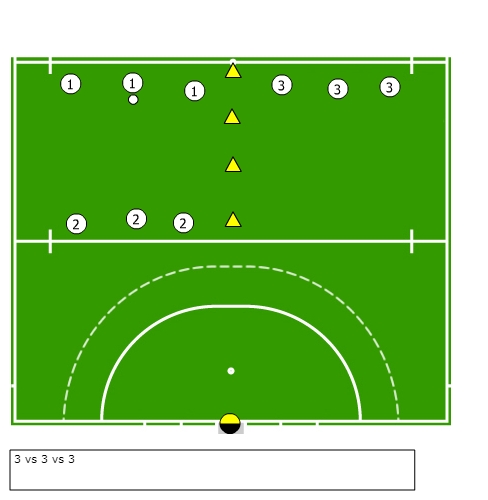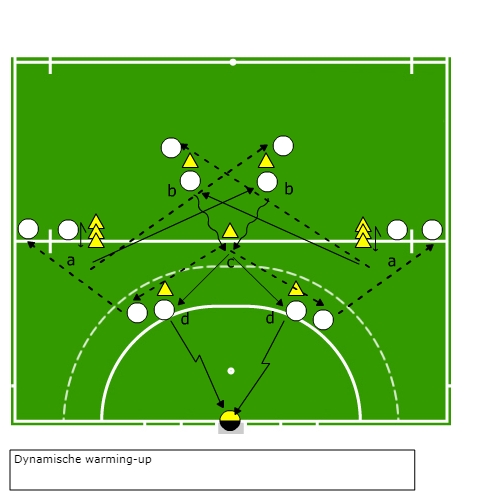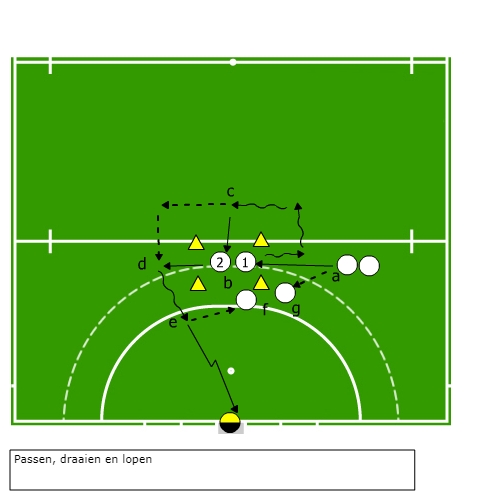Hockey drills
Goal
- To practise running through the ball in motion (accepting in the run).
Set up
- 2 players stand in a line (e.g. sideline)
- and 1 player stands 10-20 metres away.
- The first player of the team runs a few metres and then passes the ball to the second player.
- and passes the ball to the person standing alone.
- He starts running roughly at the time of the pass.
- This way, he runs through the ball at the moment he takes over.
- The person who passed then moves to the 1-ling position
- The exercise can be made more difficult by lengthening the distance between passes In addition, a passing move can be made before the pass.
Purpose
- Practicing different techniques. (Also useful to observe how things are going during the 1st training).
Set up
- All players line up on the baseline (or another line) and do a certain
- and do a certain exercise until the 23m line (or another line).
- This can be only floating, or floating + at whistle a drag or lift, etc.
- Important is that it is not about the fastest, but the best!
- You can make it easier or more difficult by making a difference in the exercise.
Goal
- To regain that ball feeling and get back into the swing of things.
Set up
- The players form pairs
- and they stand opposite each other on a few meters (5 for example).
- Then they start pushing each other.
- At a certain moment, they take some more distance and start flattening.
Goal
- The goal of this exercise is to learn to look ahead when floating. In addition, you train your ability to react.
Set up
- The players line up on, for example, the back line.
- The trainer stands 10-15 metres away from the players.
- At an agreed signal, the players start drifting towards an imaginary line at your height.
- But in the meantime, they have to look in front of them, because you raise a certain number of fingers and the players have to say that number.
- To make this exercise more difficult, you can ask the players to make a passing move on an agreed signal, or you can make the distance bigger, or the players have to walk instead of saying the number, to a point which corresponds with the number.
Play a 2-1 and try to score in the goal.
If the defender captures the ball, he passes it to the next duo.
Alternate the defender.
There is a square just outside the 23 in the middle.
3 teams between 4 and 6 players.
- Team A starts attacking from the right, trying to score;
- Pay attention to scoring positions (guard, spot, 2nd pole);
- If team A scores, the coach throws in a bonus ball
- If the ball goes out, it is for team B(defence)
- Team B's task is to play into team C's position;
- Team C then moves the ball to the right and starts attacking.
- Team A then goes to defend
- A plays the ball to the incoming B
- B rebounds the ball
- A drives a little
- B offers himself wide and A plays the ball into the space to B
- Because of B's running action outside, C makes space by running inside.
- B accelerates during his running action with the ball over the back line.
- C has gone towards the dot
- B passes, C rounds off (one-touch).
Variation: Exercise 2x.
Start with a three-run.
- A floats with the ball, when A is halfway, he pushes the ball out of the run to B.
- B does the same (to C)
- etc.
- Apply differentiation.
Possibly after this warm-up play another game of possession.
Goal
:To be able to quickly switch between offense and defense.
Format
:The field between the 23m line and the halfway line is divided into two parts. There are three teams of 3 players. Two teams play against each other, the remaining team has a break.
- Team 1 and 2 play against each other. Goal of team 1 is to score, goal of team 2 is to get the ball to team 3.
- When one team scores, the other team has to start the next game as defender. E.g. Team 1 scores against team 2, then team 2 plays as defensive team against team 3.
- When team 2 has taken possession of the ball, they play it to team 3. Team 3 starts attacking team 1 as soon as they receive the ball. Team 1 must then switch from attack to defence. Team two now takes the place of team 2 and awaits the play between 3 and 1.

Variations:
- The number of players per team can be adjusted.
- The field can be made narrower.
Points of attention:
- The game should continue as much as possible. To do this, it is useful to have a lot of balls with you as a coach so you can throw them into the exercise.
Purpose
: To get warm through a combination of passing, running, and picking up in the run and from standstill.
Format
:This exercise is also known from volleyball. The pawns are not exactly in a triangle. It is possible, depending on the number of players, to set up a multiple of the exercise.
- The player at A passes the ball straight to the player at B.
- The player at B plays the ball to the player at C and runs towards point A.
- The player at C receives the ball at point D and passes it to point A.
- For the changeover, A runs to B, B via D to C and C to A.

Variations:
- Variations can be made in terms of stroke. (hit, push, flats)
- The distances can be made larger or smaller to adjust the level of difficulty.
- Pawns can be placed to play in between. This is to increase the purity. When you make the cones smaller, the degree of difficulty increases.
- To play the ball from C to D there can be bounced.
- To play the ball from D to A you can play bounce.
- You can also place point C on the other side so that you reverse backhand and forehand.
- When you place point C at 90 degrees from point B, you can do the same exercise, only then you will hit point D from a different angle.
- When you set up different situations, you can rotate the exercise. Situation A is the standard, in situation B the exercise is mirrored, in situation C the exercise is set up so that point B and C are at 90 degrees from each other and situation D is a mirror of situation C.
Points of attention:
- As a trainer you can take a good look at the different techniques of your players.
- Sit low at the take-off.
- When playing the ball from C to D, the ball may not shoot too far in the direction of A. The intention is that the player coming from B should take the ball at right angles.
- Play the ball on the forehand where possible.
- Stand ready to receive the ball. (low to the ground, stick on the ground)
Purpose
: Various technical forms to warm up.
Format
:The exercise can be set up one-sided or two-sided. This depends on the number of players in the training.
- At point A, the player makes a drag and passes the pawns. Then he passes to the player at point B.
- The player at point B takes the ball and dribbles to point C. From there he passes to the player at point C.
- The player receives the ball and turns towards the goal, completing the pass
- Before turning, you run after the ball. Point D rejoins point A again.

Variations:
- You can set up the exercise single-sided and double-sided.
- You can also choose to warm up the goalkeeper in this way.
- At C, you can switch sides. If you are coming from the right, play the ball to the right, so that you can practise from both sides.
Points of attention:
- This is a good time to look at different techniques of your players and polish them.
- When turning and dribbling, the ball must stay on the stick.
- There is only one point at C, so players should not get in each other's way and look for the next ball to enter play.
- All balls are played into the forehand of the teammates.
Goal
:To increase ball skills by alternating between playing without and with the ball, floating, hitting and bouncing.
Set-up
:A square just outside the circle is set up.
- The player outside the square plays the ball into the square.
- The ball is accepted by player 1. He takes the ball and drives around the pawn to point C.
- At point C he plays the ball into the square to player 2 and runs on to point D.
- Player 2 plays the ball to point D so player 1 can pick up the ball there.
- Player 1 walks to the edge of the circle and shoots at the goal from inside the circle.
- Before turning, player 1 takes the place of player 2; Player 2 goes to play the ball; The player who played the ball in becomes player 1.

Variations:
- Instead of shooting at the goal, you can also tip the ball in.
- Player 2 can play and pass instead of taking the ball.
- The exercise can also be played from the other side.
Points of attention:
- The ball stays on the stick. When the ball is attached to the stick it is almost impossible to take it away without a foul.
- Player 2 must play the ball in the right direction.
- To make sure the exercise runs smoothly, there must always be a reserve player at points F and G.







